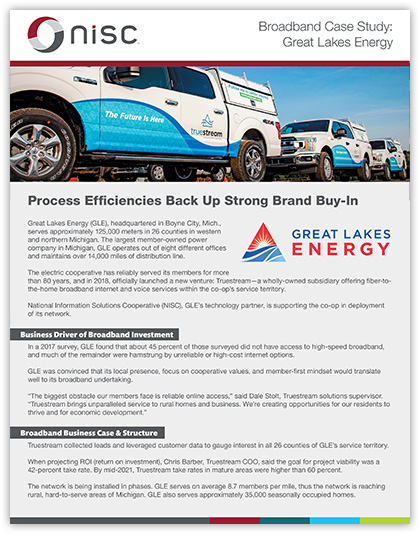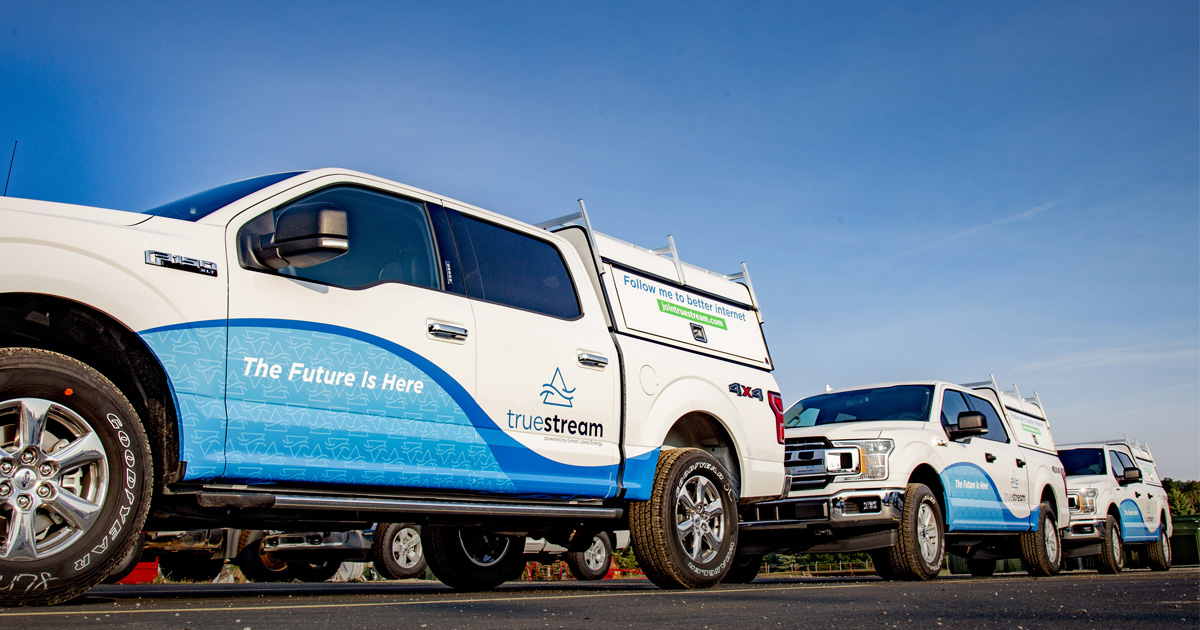Great Lakes Energy (GLE), headquartered in Boyne City, Mich., serves approximately 125,000 meters in 26 counties in western and northern Michigan. The largest member-owned power company in Michigan, GLE operates out of eight different offices and maintains over 14,000 miles of distribution line.
The electric cooperative has reliably served its members for more than 80 years, and in 2018, officially launched a new venture: Truestream—a wholly-owned subsidiary offering fiber-to-the-home broadband internet and voice services within the co-op’s service territory.
 |
| Click here to download |
National Information Solutions Cooperative (NISC), GLE’s technology partner, is supporting the co-op in deployment of its network.
Business Driver of Broadband Investment
In a 2017 survey, GLE found that about 45 percent of those surveyed did not have access to high-speed broadband, and much of the remainder were hamstrung by unreliable or high-cost internet options.
GLE was convinced that its local presence, focus on cooperative values, and member-first mindset would translate well to its broadband undertaking.
“The biggest obstacle our members face is reliable online access,” said Dale Stolt, Truestream solutions supervisor. “Truestream brings unparalleled service to rural homes and business. We’re creating opportunities for our residents to thrive and for economic development.”
Broadband Business Case & Structure
Truestream collected leads and leveraged customer data to gauge interest in all 26 counties of GLE’s service territory.
When projecting ROI (return on investment), Chris Barber, Truestream COO, said the goal for project viability was a 42-percent take rate. By mid-2021, Truestream take rates in mature areas were higher than 60 percent.
The network is being installed in phases. GLE serves on average 8.7 members per mile, thus the network is reaching rural, hard-to-serve areas of Michigan. GLE also serves approximately 35,000 seasonally occupied homes.
Existing competition includes cable operators, satellite broadband, digital subscriber line (DSL), and wireless internet service providers (WISP). To differentiate, Truestream offers a simplified approach to pricing and products, symmetrical product offerings, and a high level of customer service GLE members are accustomed to.
Challenges and Surprises
GLE navigated workflow inefficiencies, including the manually intensive delinquent and collection processes, that resulted in ineffective use of staff time and resources. Prior to partnering with NISC, time- and paper-intensive processes resulted in strain on employees and less-timely customer service.
Additional challenges include operational hurdles posed by serving a large, non-contiguous service territory, limited access to construction workforce and materials, managing the financial capacity to build the necessary infrastructure, and managing customer expectations.
“The excitement level was high—even people outside our service territory were asking to get on the list,” said Jonathan Auman, GLE business systems supervisor. “We’ve done well managing customer expectations, but it’s hard to tell members it’ll be months, if not years, for us to build out the network in some areas. People need service now.”
Among the greatest successes has been brand buy-in by Truestream customers, known as “Truestreamers.” The formation of these brand ambassadors is reflected in a measured customer satisfaction rating of over 95 percent and a net promoter score of 87.
“As a member-owned cooperative, we’re used to members having strong feelings of investment and ownership in their co-op, and that mentality has taken root in the broadband side of the business,” Barber said. “I think it’s because we’re a local brand people know and trust, and it’s just the spirit of the co-op and how we care for our members.”
Why This Case Study is Important
One factor behind the success of Truestream is the importance of finding process efficiencies, particularly in the areas of mass disconnects and reconnects.
Prior to partnering with NISC, disconnecting a delinquent account meant manually writing a service order, watching for when the debt was paid even if outside business hours, creating another service order, and manually reconnecting the account. Each delinquent account required about 10 minutes of a staff person’s time, which was then multiplied by however many disconnects occurred that month.
Now armed with automation, reconnects occur automatically 24/7 with no human intervention, and total staff time required for each month’s entire reconnect process is a total of 15-30 minutes—most months a savings on staff time of more than 90 percent. The software also applies to the electric side of the utility and helps ensure credit history events are recorded in those accounts.
“It means increased data integrity. Before, this labor-intensive process opened the door to human error, but now the system is doing it and we know that when we disconnect somebody, all the pieces and parts that go with it are accounted for,” Auman said.
Truestream notched its first subscriber Oct. 25, 2018, and currently serves more than 12,000 internet and voice subscribers. With an annual growth goal of 6,000 new Truestreamers, tools such as mass process automation help ensure customers are as pleased with their broadband services as they are with their electric service.
This case study was originally published in NRECA RE Magazine’s 2022 Broadband Insert in August 2022.
